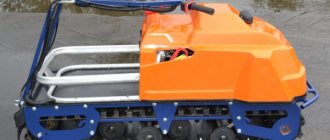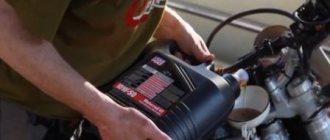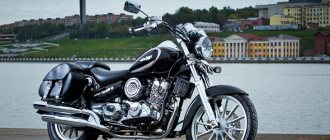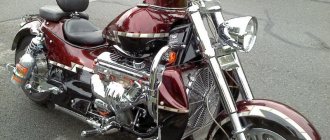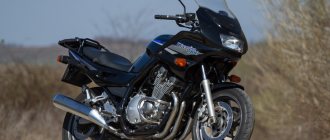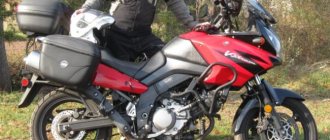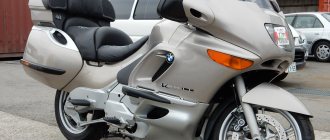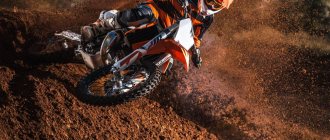Four-wheeled motorcycles have gained great popularity among various technology enthusiasts. They are more stable, have a beautiful design and increased maneuverability. ATVs are used for sports and performing various tricks. Other models are ideal for working in rural areas, while highway options allow you to travel in comfort. There are miniature versions for children to ride around a field or large yard. What parameters should this motorcycle have for certain conditions in order not to get stuck on soft ground, jump over an obstacle or travel a long distance is described in this article.
The best ATV manufacturers - which company to choose
To buy reliable equipment and use it for a long time, you can contact one of the well-known companies that produce them:
1.CF Moto
2.Honda
3. Kawasaki
4. Stels
5.Yamaha
It wouldn’t hurt to see the advantages and disadvantages of specific popular models that are listed in the ranking of the best ATVs. This will help you more accurately determine the type and capabilities of the vehicle.
Well, for a detailed independent selection of all key characteristics, the material below is intended.
Recommendations: 12 Best ATVs
13 best tubes (cheesecakes)
9 Best Fuel Tanks
Double models
Many utility ATVs are equipped with two seats, but there are also models with a single driver's seat. When deciding for yourself which utilitarian two-seater ATV to choose, it is also important to pay attention to other characteristics.
Kawasaki Mule Pro-DXT
The key feature that distinguishes this utilitarian two-seater ATV from others is the diesel engine. Despite the fact that this difference does not appear outwardly, experienced ATV riders note that the difference is noticeable.
The engine of this model has a displacement of 993 cubic meters, it is three-cylinder and fully complies with EPA Tier 4 requirements. Compared to a gas engine (for example, in the Mule Pro FX and Pro-FXT models of the same brand), a diesel engine is more reliable and economical to operate by 10 -20%.
Interesting! This model features a belt drive that is four times stronger than older Kawasaki ATVs. In addition, the Kawasaki Mule Pro-DXT is equipped with a convenient and simple CVT. All these details make the ATV as maneuverable and easy to control as possible.
Russian mechanics RM 800 UTV
A universal domestic model in the category – two-seater utilitarian atv quad bikes. Compared to other Russian-made utility vehicles, the RM 800 UTV is a low-budget option. Its cost reaches $10,000 depending on the configuration.
The ATV is equipped with a powerful 800cc two-cylinder engine. It is maneuverable and safe for off-road travel in any conditions. Another convenient feature is the ability to disable front-wheel drive where it is not needed. Thanks to this variability, the ATV uses fuel more economically.
Important! For additional safety of the driver and passenger, the ATV has lateral seat support, a windshield, and the ability to install a roof.
Operating principle and structure of the ATV
In terms of internal elements, an ATV is very similar to a regular motorcycle, but the important condition is the presence of four wheels and the central location of the saddle between this base. This design provides high stability when turning, jumping and landing, and also allows you to load the device more by weight.
ATVs are used in different ways:
1. For sporting events where you need to perform various tricks and jumps.
2. To work in rural areas, where you need to get to a field or forest area, bring tools, spare parts. The equipment has a towbar to connect a cart or attachment. They are used by fishermen and hunters to engage in their favorite hobby.
3. Extreme tourism on such models is especially interesting, because it allows you to drive through mountains and rough terrain.
4. Four-wheelers are also used for traveling on highways. Specialized suspension, transmission and wheels provide comfort of movement as in a small car.
5. For children who like technology, smaller models with low speed and maximum safety are intended. They can be driven along a field or rural road, under the supervision of adults.
To ensure that all of the above functions are performed, the creators carefully consider the design of the ATV, which in most cases includes the following elements:
- power unit;
- gearbox;
- metal frame for fixing equipment;
- shock absorbers;
- wheels;
- ignition and fuel supply system;
- steering wheel;
- brakes;
- saddle;
- cooling system;
- headlights;
- trunk;
- rear view mirrors;
- plastic decorative lining.
Thanks to a well-thought-out suspension, high wheels with pronounced lugs and powerful power units, ATVs are able to travel where other equipment is powerless. This allows you to move through sand, swamps, black soil, grassy fields, often forests, and stones. But using such a vehicle requires a license (except for children's models and driving off the road).
For long-term operation, regular maintenance of the equipment is required: cleaning the carburetor, monitoring the oil level in the engine, replacing seals in shock absorbers, tightening mounting points.
To start driving, you need to sit in the saddle, turn the key, start the engine with an electric starter, engage first gear or move forward at high speeds of the variator and smoothly press the gas trigger. The device will start moving. The harder you press the trigger, the faster the speed.
To pass over rocks and ravines, it is necessary to set the variator position to move forward at reduced speed. To change back, the handle is rearranged in accordance with the designation. Braking is carried out by hand brake or pedal. For emergency shutdown of the engine in unforeseen situations, a check is provided on the right side.
What it is
The principle of operation of the equipment is similar to that of a motorcycle, but the fundamental difference is the presence of two additional wheels. This design feature allows the vehicle to be more stable, maneuverable, safe and convenient, especially for those new to driving. Who might need such transport? First of all, an ATV is often used for outdoor activities associated with extreme sports, stunts, and sporting events. Also, such transport has been in great demand in agriculture in recent years. For example, a worker can easily get to the site, transport tools there, and if desired, additional equipment can be attached in the form of a small trailer. In addition, hunters and fishermen like to use ATVs.
If you are a fan of tourism and various hikes, this vehicle is quite suitable for traveling through mountainous terrain, sandy surfaces and flat highways.
The maneuverability of the unit is due to the presence of high-quality suspension, large wheels with a coating that firmly adheres to the ground, and the performance of the equipment directly depends on its powerful engine. Thanks to such distinctive features, the vehicle copes with various obstacles that other types of equipment cannot cope with.
Types of ATVs
There are four types of four-wheeled vehicles with a saddle in the middle. Each has its own characteristics and scope of application.
Children's
They have a compact design and are designed for one passenger. They can be used by children from 6 to 12 years old. The maximum speed of 45 km/h will not allow you to accelerate to dangerous values. Most models have a remote engine shutdown system.
The equipment supports the transportation of a driver weighing up to 55 kg. The device is suitable for children to play under the supervision of adults in open areas (field, park, large yard), away from the roadway.
Advantages:
- relatively inexpensive;
- simple equipment and maintenance;
- sufficient load capacity;
- Beautiful design;
- sophisticated security system;
- presence of reverse gear.
Flaws:
- after the child has grown up, it cannot be used;
- low fuel supply;
- small battery capacity.
Utilitarian
The most popular type of ATVs due to their universal use. They are distinguished by powerful engines, good suspension, high ground clearance and wheels with pronounced lugs. The strong frame allows the equipment to be loaded with two passengers or luggage.
Suitable for extreme tourism, hunting, fishing, as working equipment in the garden, and walking on uneven terrain. Equipped with thick protective arches that protect against impacts on the body.
Advantages:
- powerful power units;
- average speed;
- high maximum passenger weight;
- high ground clearance;
- wide wheels do not sink in sand or soft soil;
- high-quality suspension;
- There are models with liquid cooling;
- widespread use of the vehicle;
- large tank volume.
Flaws:
- heavy;
- fuel consumption is higher than other types;
- expensive.
Road
They stand out for their large engine capacity and high speed, allowing you to drive on the highway with sufficient comfort and speed of a small car. Suitable for all ages. They have cooling from a circulating fluid system and wide chassis with good grip on smooth asphalt. The ground clearance of these types is not the highest, due to their intended purpose for a flat surface.
Advantages:
- beautiful design, different from the classic ATV;
- high speed;
- wide wheels, like a car;
- stable when cornering;
- alloy wheels;
- digital speedometer.
Flaws:
- there is a manual transmission, which is not familiar to all beginners;
- A small tank means frequent refueling.
Sports
Their device is designed to ensure a minimum mass of the device in order to perform jumps and other tricks. They are distinguished by small fuel tanks, a saddle for one person, and engines of medium volume and power, which allow the equipment to be loaded for a short time for acceleration and derailment. Suitable for regular hobby for young and old people.
Advantages:
- small weight;
- narrow tires;
- acceptable power;
- good shock absorbers;
- stable fuel injection;
- high seating position, which allows you to operate both standing and sitting.
Flaws:
- small tank volume;
- there are very expensive models;
- low ground clearance, although you have to drive on dirt and sand.
Suspension designs
The suspension of an ATV is one of the most important elements that is responsible for the vehicle’s maneuverability in difficult off-road conditions and directly affects the control and handling of the ATV.
There are two types of suspensions: independent and dependent.
Let's take a closer look at them.
Independent
or multi-link suspension is designed for better maneuverability and comfort. For cross-country ability, it is important that when going over uneven surfaces, the wheels do not lose contact with the surface, in other words, do not hang out during critical suspension moves. Constant contact with the surface gives better cross-country ability in off-road conditions, because each of the wheels has an engagement with the surface and the equipment does not stand up. Also, an independent suspension has much higher ground clearance than an ATV with a dependent suspension. In other words, your ATV will not sit on its belly.
Dependent
suspension or axle (axle) is used in sports ATVs designed for quadrocross, inexpensive Chinese models with small cubic capacity and children's ATVs. This type of suspension is more durable in operation and has better torque transfer from the gearbox to the wheels. But it has a number of disadvantages:
- not so comfortable suspension
— easily hangs out on uneven surfaces, thereby losing contact of the wheel with the surface
- not suitable for serious off-road use.
Despite its disadvantages, this type of suspension is used on sports ATVs. Simplicity of execution and reliability became the basis when choosing an ATV for serious multi-day marathon rallies such as the Dakar.
ATV selection options
To choose a vehicle that suits your needs, you need to understand the impact of specific performance values on operation.
Engine capacity
The first parameter on which the convenience and possibilities of use depends is the volume of the power unit. There are models from 100 to 698 cm3:
1. To ride a child around the yard or field, you need no more than 108 cm3, this will allow you to enjoy riding faster than on a bicycle, but while maintaining a sufficient level of safety for the young passenger.
2. For household needs (harvesting, going fishing), you need ATVs with a large volume from 150 to 230 cm3. Driving on dirt or grass will not be difficult.
3. To cruise along the highway at good speed, choose engines from 150 to 280 cm3.
4. Extreme tourism and overcoming steep slopes, loose sand and huge stones are easily covered on motors with a parameter of 350-689 cm3.
5. For sports that require acceleration before jumping, an indicator of 150-170 cm3 is sufficient.
Power
The parameter affects the ability to sharply increase the speed at the right moment and determines what kind of cargo the equipment can carry:
1. For children, no jerking is required, and their weight is minimal, so they buy four-wheeled vehicles with 6-7 hp here.
2. Driving on a flat road does not require quick overtaking (not the right type of vehicle) and 13-18 hp are needed to develop the required speed and maintain it while driving calmly.
3. Using an ATV for tourism or transporting cargo, on the contrary, requires power to give it gas and get out of a ditch, drive over a log at low speeds, or deliver boxes of vegetables in the trunk. Indicators from 13 to 45 hp are appropriate here. The more loads are planned, the higher this number should be.
4. Single-seat models for training jumps only need short-term intensive work during acceleration, and 13-15 hp is enough.
Speed
An ATV cannot be called a high-speed vehicle, but even here there is a decent run-up parameter that needs to be taken into account. For young drivers (6 to 12 years old) to travel safely, the speedometer does not need to exceed 45 km/h. In contrast, cruising on the highway is more enjoyable at 80-95 km/h, which is the cruising speed of a regular car. Transport for fishing and hunting will not allow you to accelerate over hilly terrain, so 75 km/h is enough here to get to the forest along the dirt road, and then move at 20-40 km/h.
Ignition system
There are three ways to start the engine, which differ between models:
1. Electronic system - requires turning the key and pressing a button, after which the engine hums and is ready to go. It is convenient for everyone, including children and girls. Practical for non-technical people. Suitable for highway driving or children riding.
2. Manual system - requires a pull of the cable on a special handle, which forces the engine to rotate. It is not so comfortable to use and requires some physical strength. But such models are cheaper and will come in handy when fishing or hunting with an experienced driver.
3. Combined - contains a button for comfortable starting, but in case of its failure, it allows you to force the power unit to rotate. This is necessary for long trips (hunting, extreme tourism), where it is not possible to go to a workshop.
Fuel supply system
There are two ways to redistribute gasoline from the tank to the engine. A carburetor is cheaper and easier to maintain and repair, but its consumption increases. This is suitable for infrequent fishing trips or transporting vegetables from the garden. The injector is more demanding and “capricious”, but significantly saves fuel. Useful for long-distance trips or regular sports activities.
Transmission
Shifting gears on ATVs is carried out in different ways:
1. A manual transmission requires constant attention from the driver and manual movement of the lever without taking his eyes off the road. This is suitable for driving on the highway, where the surface is flat and there is no shaking or bumping.
2. The variator implies setting the lever to move forward even at the start and then requires attention only when encountering an obstacle or loose surface, where it is necessary to move the lever to a position with reduced speed. It is practical for country use, hunting and fishing.
3. The automatic transmission requires no attention from the driver at all, and he can concentrate on the road. The “smart” unit itself will adjust the gears depending on the load on the engine and its rotation speed. This is convenient for driving in the mountains, where it is important to watch the road so as not to fall into a steep cliff, or when playing sports, where all attention is given to performing a trick.
Cooling system
The engine, burning fuel, can overheat. To prevent excessive expansion of internal elements and jamming, a cooling system is provided. The air type is suitable for occasional use on trips for fishing, hunting, cargo delivery or walking. Riding every day and for many hours requires a fluid system that allows for greater heat transfer. This is good for road vehicles and long tourist trips with high engine load.
type of drive
Torque from the engine is transmitted to the rear axle through a metal chain and sprockets. This is a reliable system, also used in motorcycles, which is suitable for traveling through fields, forests, sand, sports jumps or transporting boxes and bags on dirt roads. But if the technique is used on very steep climbs, driving over huge stones, then the chain may not withstand the sudden load and break. In such situations, a driveline torque transmission is better suited. The connection made of solid metal pipes and bearings is much more reliable and stronger.
Brakes
High-quality brakes will help you avoid an accident or going off the route. They are activated by pressing the bracket with the handle (front brake) or pressing the pedal with your foot (rear brake). Both options have discs and hydraulic pad clamping.
On models with a low maximum speed of up to 50 km, there is no need for a front brake. Often these are children's ATVs. The rear brake or remote engine shutdown by a watching parent can help avoid a collision. For all other cases, both types of brake are required.
Seat height
The comfort of driving an ATV is determined by the driver’s seat height relative to ground level:
1. Children will need low saddles of 600 mm in order to freely reach the ground and climb off.
2. The sport requires riding either sitting or standing (at the time of performing the trick), so an average seating position of 700 mm is required here.
3. Long rides on the road or field are comfortable with a saddle height of 760 mm.
4. It is practical for tall people (from 180 cm) to buy ATVs with a parameter of 880 mm.
Load capacity
The maximum user weight, the number of passengers and the weight of transported luggage depend on this factor. For children to ride, there is no point in buying equipment with a rating of over 50 kg. To comfortably travel or walk together, you need a value of 145-200 kg. The equipment that is planned to be used for transporting cargo (harvest, tools, spare parts) can reach 350 kg of carrying capacity.
Volume of the tank
Although the fuel consumption of an ATV is low (about 2.5 l/100 km), the size of the tank will affect the driving range without an additional canister or refueling. Children who ride close to home need a device with a capacity of no more than 2.5-3 liters. Fishing and hunting will require a fuel supply of 200 km, so the tank should be 5-6 liters.
There are often gas stations on the asphalt road, so road units do not need a large supply and 7 liters is enough. Sports versions, on the contrary, need to be unloaded and not completely filled, so 4-5 liters is enough. A trip far into the mountains is associated with unforeseen situations and changes in the route, so a tank of 12 to 22 liters is desirable.
Signaling
You can install such an element yourself, but there are models with a built-in system. It will come in handy if you need to leave your equipment in a parking lot (when traveling), in the forest (hiking) or in the courtyard of a multi-storey block. Owners of private houses and garages can save money.
Suspension
The suspension affects the softness of the ride and comfort when moving over holes and obstacles. A common option is two levers and ball shock absorbers at the front, allowing you to drive onto a curb or jump out of a rut, as well as a pendulum suspension with one hydraulic shock absorber at the rear. This is enough for driving on a field, sand, asphalt or dirt.
More severe road conditions are better handled by ATVs with independent double wishbone suspension with springs and hydraulics both front and rear. This will allow you to move over logs, boulders, and ravines with steep walls.
Ground clearance
No matter how powerful the engine is, if the equipment rubs its bottom against the ground or stones, it will be difficult to drive. The ground clearance indicator is important here. To move on asphalt, you don’t need much value and 95 mm is enough. Sports models make do with a value of 100 mm. Using equipment in the village (transporting hay in a trailer, vegetables) or hunting requires 120-150 mm. For mountainous and forested areas there are models with a clearance of 265 mm, allowing you to move over a large stone or fallen tree.
Tire size
Tire size affects stability during maneuvers and the degree of failure on soft soil. To ride on hard ground, you need wheels with a width of 170 mm (garden, vegetable garden, field). Forest, sand and marshy edges will require 185 mm. To drive on smooth asphalt, you need a large area of contact with the surface, so choose 235-270 mm.
Disc type
Steel wheels look less attractive, but due to the soft structure of the metal, they withstand impacts from obstacles, holes or jumps well. To move through the forest, ravines and rocks, only these wheels are needed. This is also optimal for sports.
On the track, apart from the grooves, there are fewer threats, so you can install cast alloy wheels. They have a nice design and reduce the weight of the ATV, but if you hit a curb on them at high speed, the material can split.
Do you need a license to drive an electric ATV?
Category L6 is considered the most common in Russia. ATVs with an electric motor with a power of up to 4 kW are considered road bicycles; therefore, to use such an ATV it is not necessary to have a driver’s license. It is advisable not to use this type of transport for off-road driving, but to explore city parks and walk along pedestrian areas. If such an ATV is directly involved in road traffic, you will need to obtain a category M license.
In this case, no license is required to operate an electric ATV; you can safely move along sidewalks, parks and any other pedestrian area. The main thing is not to go on trips (especially since low-power electric ATVs are not designed for this).
Which ATV to choose
Having considered all the nuances and features of the ATV, we can formulate requirements for specific needs:
1. To ride near the house or in the field, a child will need an engine capacity of 108 cm3, a power of 7 hp, a speed of no more than 45 km/h, electronic ignition, a carburetor and air cooling. A 3-liter tank and rear hydraulic brakes complete the package.
2. For hunting and fishing, you need a 149 cm3 power unit, with a variator, pendulum rear suspension, a chain on the axle, a carburetor, 13 hp, a maximum speed of 70 km/h, and a wheel width of 170 mm, tank size 7 l. With a load capacity of 140 kg, you can take everything you need. Ground clearance is about 100 mm.
3. Extreme tourism is mastered with equipment with 30-45 hp, engine capacity 400-689 cm3, injection injection, independent suspension, driveshaft, electronic and manual ignition, liquid cooling system, saddle height 800-880 mm and a load capacity of 300 kg. You need a large tank of 22 liters and wheels 250 mm wide. It is convenient to regulate the speed using a variator or automatic transmission.
4. You can perform sports stunts on a unit with an engine capacity of 176 cm3, a speed of 75 km/h, a power of 17 hp, a carburetor and electronic ignition. Hydraulic disc brakes on all wheels are required, and tire widths need to be up to 180-220 mm. The seat height is about 700 mm and the ground clearance is 125 mm.
5. To travel on asphalt, you need equipment with an engine capacity of 246 cm3, which allows you to accelerate the vehicle to 80 km/h. In terms of power, you will need 16 hp, carburetor injection and a manual gearbox. Due to the conquest of long distances, a liquid cooling system is important. Ground clearance is 95 mm and wheel width is 270 mm. A 6 liter fuel tank is quite enough.
Specifications
The SUV can “boast” of a V-shaped engine with a SOHC liquid cooling system, that is, it has one camshaft located at the top. To prevent the ATV from getting stuck in bogs and swamps, the developers were not stingy with the engine displacement of 976 cc. 82 horsepower helps the 370-kilogram “heavyweight” develop decent speed.
Since the number of seats is 1+1, the Outlander dimensions are large: length 2388; width 1168; height 1350. In addition, the SUV's ground clearance is 279 mm and the seat height is 877 mm. Long trips are ensured by a spacious tank with a volume of 20.5 liters. It happens that due to the driver’s inattention or due to extreme road conditions, the ATV is subject to impacts, or rather its frame. Even with such strong impacts, the second generation spatial beam technology (SST) ensures the strength of the entire structure of the model and its further movement. The Carlisle Badland front and rear wheels, measuring 26'' x 8'' x 12'' and 26'' x 10'' x 12'' respectively, provide high-quality traction, eliminating the possibility of slipping even on the most slippery ground.
Appearance
Having seen this two-seater beast in action, how it smoothly corners, one might say gracefully overcomes off-road conditions, the following conclusion must be drawn - the engineers of the Can-Am brand did an incredible job during the development of the suspension of the ATV. The front suspension component is designed on the basis of A-arms, and the rear suspension is an independent torsion bar suspension with longitudinal arms. Practical trials and tests confirmed the correctness of the technical solution made (relating to the suspension), due attention should be paid to high maneuverability, with sufficient dimensions of the ATV. Let us remind you that the wheelbase of the model is 1499 mm. The braking system is based on ventilated discs, two discs are installed on the front brake, and one disc on the rear brake. Each disc has a hydraulic two-piston caliper.
Going into the design features of the Outlander MAX 1000 LTD, it is necessary to mention the multifunctional digital instrument panel, which contains: a diagnostic center, warning lights, speedometer, tachometer, clock, engine fault indicator. The SUV is also equipped with a GPS navigator and a DC socket (cigarette lighter). The design of the iron horse is interesting and modern. Plastic is environmentally friendly and durable; it is used to protect hands and feet.
An Outlander can serve not only as a vehicle for traveling or active recreation, but also as a reliable assistant that will transport cargo. The SUV is equipped with rear and front luggage racks, the first is designed for a load of up to 90 kg, and the second up to 45 kg. Having become acquainted with the many advantages of the Outlander MAX 1000 LTD, a mad desire arises to buy a two-seater utilitarian ATV.
